Proposed SGIP Decision Would Continue to Squander Millions on Polluting Generation

As Governor Brown recently characterized the climate crisis, "We're on the Titanic unless we turn." Yet at the California Public Utilities Commission (CPUC) it sometimes seems like the band plays on, oblivious to the urgent need for action to clean the grid and transition away from fossil fuels. Case in point is a recent proposed decision by Commissioner Picker updating eligibility criteria for California's Self Generation Incentive Program (SGIP). SGIP is an $83 million a year ratepayer-funded program intended to support clean and innovative distributed energy technologies. To qualify for SGIP funding, a project must demonstrate that its greenhouse gas emissions are below a certain threshold. Picker's decision would set this emissions threshold at a level significantly higher than a modern gas plant, thereby allowing millions of dollars in SGIP subsidies to flow to carbon-intensive distributed resources. SGIP's emissions limit must be lowered to ensure this landmark program is focused on spurring development of the much cleaner technologies critical to achievement of California's climate goals.
Background: SGIP's Mixed Performance and Legislative Reform
SGIP originated during the energy crisis as a means to diversify California's energy supply by providing incentives to distributed generation. With climate change an increasing concern, the Legislature amended SGIP in 2009 to limit eligibility to distributed resources that achieve reductions of greenhouse gas emissions.[1] In implementing this requirement, the CPUC set a qualifying emissions threshold based on the carbon intensity of the electric generating fleet as a whole. This standard meant that resources with emissions only incrementally lower than the grid average qualified for SGIP incentives. As a result, SGIP frequently functioned to heavily subsidize fossil-fuel dependent technologies with little, if any, environmental benefit. As illustrated in the graph below, greenhouse gas reductions from SGIP-funded projects are almost entirely driven by renewable sources like wind turbines and biogas projects even though they receive only a fraction of overall SGIP funding.[2]

Fossil-fuel dependent technologies, which have constituted over 70 percent of deployment under SGIP,[3] either result in nominal reductions or actually worsen pollution. For example, the performance of the natural gas fuel cells historically subsidized by SGIP can quickly degrade and become substantially more polluting over a short period of time.
To address the shortcomings in SGIP's environmental performance, the Legislature again amended the program in 2014 to further emphasize greenhouse gas reduction, finding that the success of SGIP is based not simply on whether a resource would reduce greenhouse gases, but on “the amount of reductions.”[4] The Legislature's recent reauthorization of SGIP continues the program until 2021 and commits an additional $415 million in ratepayer funding for distributed energy resources expected to operate through at least 2030. New SGIP projects will also be deployed at a time when California has committed to aggressively reduce greenhouse gas pollution to 40 percent below 1990 levels by 2030. If SGIP continues to subsidize fossil-fuel dependent technologies in lieu of less polluting alternatives, achievement of California's ambitious and needed climate goals will be even more difficult.
The Proposed Decision – A Nominal Reduction in Emissions Eligibility
Despite legislative direction to ensure SGIP results in meaningful greenhouse gas reductions and the significant action needed to meet California's 2030 climate and clean energy goals, Picker's proposed decision would only reduce the SGIP greenhouse gas eligibility threshold by five percent, from the 379 kgCO2/MWh standard the CPUC adopted in 2011 to 360 kgCO2/MWh. The proposed 360 kgCO2/MWh eligibility threshold allows projects with greenhouse gas emissions close to 20 percent higher than a modern combined cycle facility to qualify for SGIP incentive funding.[5] Fossil fuel-dependent technologies like natural gas fuel cells would continue to receive heavy subsidies and take away from the incentives available to less polluting technologies like energy storage, wind, and biogas fuel cells that are in line with the direction of California’s energy and climate policy.
Notably, chairs of key legislative committees responsible for passing the recent SGIP reauthorization have condemned the proposed decision, writing:
If your decision is adopted, SGIP will continue the increasingly absurd practice of subsidizing natural gas consumption, supporting existing technologies that have already taken hundreds of millions of dollars from SGIP and other public subsidies without producing substantial efficiency improvements, cost reductions, or general benefits to ratepayers, squandering the $415 million ratepayer investment authorized by SB 861 and undermining our collective efforts to clean the grid and transition away from fossil fuels.
Indeed, at the proposed 360 kg CO2/MWh limit, the "SGIP" acronym more aptly stands for "Subsidizing Greenhouse gas Intensive Projects."
The Commission can and should do better than the proposed decision. Just as the Commission has corrected shortcomings in other programs, such as in its recent decision to exclude fossil-fueled back-up generation from demand response, SGIP should be fixed to ensure it facilitates achievement of California's climate targets. Consistent with recommendations by the Sierra Club and other parties, there are a number of corrections to the proposed decision's methodology that properly lower the greenhouse gas eligibility standard and result in directing SGIP funding to cleaner resources. The time to end SGIP's checkered history of providing handouts to polluting fossil-dependent technologies is long overdue. Turning the Titanic is not an easy task. Making sure millions in subsidies are properly directed toward technologies that result in meaningful reductions in greenhouse gas pollution is a simple and obvious place to start.
[1] SB 412 (2009), adding Pub. Util. Code § 379.6(b)(1).
[2] Itron, Self-Generation Incentive Program 2013 Impact Evaluation Report (Apr. 2015) p. 7-12, http://www.cpuc.ca.gov/NR/rdonlyres/AC8308C0-7905-4ED8-933E-387991841F87/0/2013_SelfGen_Impact_Rpt_201504.pdf.
[3] Non-renewable technologies have received 238 MW of the total 330 MW of SGIP rebated capacity. Id. p. 3-7.
[4] SB 861 (2014), adding Pub. Util. Code § 379.6(l) (emphasis added).
[5] The heat rate for a Siemens H-Class is 5687 Btu/kWh. http://www.energy.siemens.com/us/pool/hq/power-generation/gas-turbines/SGT5-8000H/downloads/SGT5-8000H_brochure.pdf. Applying a CO2 conversion factor of 53.06 kgCO2/mmBTU results in emissions of 302 kgCO2/MWh.